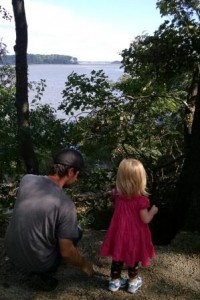 My favorite weekend activity is going to one of the awesome local parks near my Suffolk home with my husband and daughter. We play on the playground, adventure through the trails looking for frogs and squirrels and often times just enjoy the beauty of the tidal creeks that lead to the Nansemond River. Knowing what I know, it’s sometimes sad to look out on these beautiful creeks and rivers. You see, I know that the beauty we see with our eyes is often deceiving. Waterways don’t always show signs that they are struggling to support healthy populations of fish and crabs. It’s not just headline-grabbing fish kills and algae blooms that indicate an unhealthy waterway. So how do we know if our local waterway is as healthy as it is beautiful? The ‘How’s My Waterway?’ app from EPA is the easiest way for people to connect with the underlying health issues of their local waterways.
My favorite weekend activity is going to one of the awesome local parks near my Suffolk home with my husband and daughter. We play on the playground, adventure through the trails looking for frogs and squirrels and often times just enjoy the beauty of the tidal creeks that lead to the Nansemond River. Knowing what I know, it’s sometimes sad to look out on these beautiful creeks and rivers. You see, I know that the beauty we see with our eyes is often deceiving. Waterways don’t always show signs that they are struggling to support healthy populations of fish and crabs. It’s not just headline-grabbing fish kills and algae blooms that indicate an unhealthy waterway. So how do we know if our local waterway is as healthy as it is beautiful? The ‘How’s My Waterway?’ app from EPA is the easiest way for people to connect with the underlying health issues of their local waterways.
See this awesome view of the Nansemond River in Suffolk? So beautiful. But what lurks beneath is bacteria and other microbe pollution as well as degraded aquatic life. There’s also a fish consumption advisory and a shellfish harvesting restriction. Not so beautiful, huh?
So what’s your local waterway hiding from you? Find out…then take action to improve your local water quality!
(1) Use the ‘How’s My Waterway?’ app to learn about water quality near your home.
(2) Learn what causes the water quality problems in your local waterway and do something to help!
- Too much bacteria? Make sure you and your neighbors clean up pet waste and never feed wildlife like geese and ducks.
- Not enough dissolved oxygen? Only fertilize after you’ve done an easy and inexpensive soil test which tells you how much fertilizer to put down and keeps excess fertilizer out of waterways.
- Degraded aquatic habitat from cloudy water? Seed bare spots and plant more plants to help keep dirt in its place and out of waterways.
(3) Last – tell a friend, a coworker or a neighbor! Get others involved and help spread awareness about water quality in your community. By working together to improve local water quality, we can make our rivers and streams as healthy as they are beautiful!